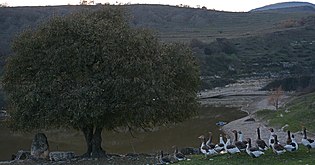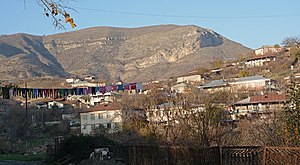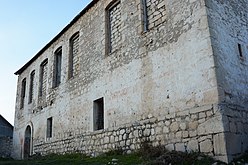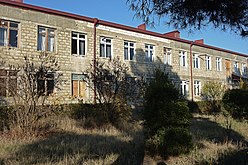Khnapat
Khnapat / Khanabad
Խնապատ / Xanabad | |
|---|---|
 | |
 Khnapat / Khanabad | |
| Coordinates: 39°58′08″N 46°49′01″E / 39.96889°N 46.81694°ECoordinates: 39°58′08″N 46°49′01″E / 39.96889°N 46.81694°E | |
| Country (de facto) | |
| • Province | Askeran |
| Country (de jure) | |
| • District | Khojaly |
| Population (2015)[1] | |
| • Total | 1,042 |
| Time zone | UTC+4 (AMT) |
Khnapat (Armenian: Խնապատ) or Khanabad (Armenian: Խանաբադ; Azerbaijani: Xanabad) is a village de facto in the Askeran Province of the self-proclaimed Republic of Artsakh, de jure in the Khojaly District of Azerbaijan. The village has an ethnic Armenian-majority population, and also had an Armenian majority in 1989.[2]
History[]
During the Soviet period, the village was a part of the Askeran District of the Nagorno-Karabakh Autonomous Oblast.
Historical heritage sites[]
Historical heritage sites in and around the village include the nearby ruined village of Jrver (Armenian: Ջրվեր) from between the 12th and 17th centuries, the ruined village of Verin Ghlijbagh (Armenian: Վերին Ղլիջբաղ) from between the 12th and 19th centuries 3 km to the west of Khnapat, a 9th/13th-century khachkar, a chapel built in 1224, the medieval cave-shrine of Mets Nan (Armenian: Մեծ նան), a 17th-century cemetery, the ruined village of Yereshen (Armenian: Երեշեն) from between the 18th and 20th centuries, the 19th-century St. Astvatsatsin Church, and a 19th/20th-century cemetery.[1][3]
Economy and culture[]
The population is mainly engaged in agriculture and animal husbandry, as well as in different state institutions. As of 2015, the village has a municipal building, a house of culture, a secondary school, a music school, a kindergarten, three shops, and a medical centre.[1]
Demographics[]
The village had 827 inhabitants in 2005,[4] and 1,042 inhabitants in 2015.[1]
Gallery[]

Landscape

Panorama

Scenery

Playground

Church

School
References[]
- ^ a b c d Hakob Ghahramanyan. "Directory of socio-economic characteristics of NKR administrative-territorial units (2015)".
- ^ Андрей Зубов. "Андрей Зубов. Карабах: Мир и Война". drugoivzgliad.com.
- ^ Kiesling, Brady; Kojian, Raffi (2019). Rediscovering Armenia: An in-depth inventory of villages and monuments in Armenia and Artsakh (3rd ed.). Armeniapedia Publishing.
- ^ Population of the Nagorno-Karabakh Republic (2005)
External links[]
| Wikimedia Commons has media related to Khnapat. |
- Populated places in Askeran Province
- Populated places in Khojaly District










